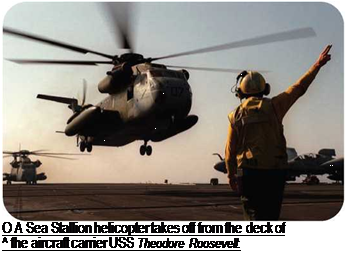Landing on a Runway
A pilot lands an airplane by first reducing power so that the plane begins to slow down and lose altitude. Closer to the runway, the engines are throttled back to reduce the airspeed even more. To make up for the loss of lift, the plane’s nose is raised to increase the angle of attack of the wings. The flaps and slats used for takeoff are deployed again, and the landing gear is lowered.
Lights and radio beacons on the ground show the way to the runway. The plane also receives two radio signals from the runway: one is the localizer and the other is the glide slope. The localizer is transmitted along the runway. It tells the crew whether the plane is flying to the left or right of the runway or is flying down the centerline. The glide slope shows whether the plane is descending at the correct rate. Just after touchdown, spoilers spring up from the wings to reduce lift and keep the plane on the ground. Jet planes often use reverse thrust to help them slow down.
Helicopters
Helicopters do not need runways to land and take off. Like rockets and airships, they are capable of vertical takeoff and landing. This gives helicopters the ability to land in and take off from small spaces or remote locations where there are no airports.
Helicopters and VTOL aircraft (vertical takeoff and landing aircraft other than helicopters) take off vertically by directing their engine power downward to thrust them upward. The helicopter pilot uses the collective pitch lever and the engine throttle to get the aircraft off the ground. The collective pitch control tilts the rotor blades, increasing their angle of attack and producing more lift. The throttle increases the engine speed, which makes the rotor spin faster. To land, these controls are used to reduce lift.
Airships
An airship is balanced so that it is neutrally buoyant on the ground. Its weight is balanced by the lift produced by the lighter-than-air gas inside it. When it is ready for takeoff, an airship’s propellers and the elevators in its tail swivel up to drive the airship upward. Modern airships are filled with helium, and they
![]()


![]() also have air-filled bags called ballonets inside them. As an airship climbs, the outside air pressure falls, and the gas inside the airship expands. Valves pop open and let air escape from the ballonets so the helium can expand safely.
also have air-filled bags called ballonets inside them. As an airship climbs, the outside air pressure falls, and the gas inside the airship expands. Valves pop open and let air escape from the ballonets so the helium can expand safely.
To land, the propellers and elevators tilt down to drive the airship down. The outside air pressure rises and compresses the gas inside the airship. The airship’s engines force extra air into the ballonets to keep the airship fully inflated as it descends.










